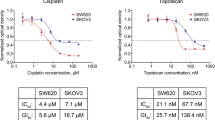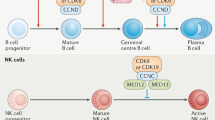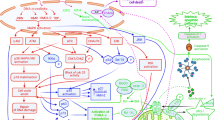Abstract
Cell proliferation is critically dependent on the regulated movement of ions across various cellular compartments. The antimycotic drug clotrimazole (CLT) has been shown to inhibit movement of Ca2+ and K+ across the plasma membrane. Our results show that CLT inhibits the rate of cell proliferation of normal and cancer cell lines in a reversible and dose-dependent manner in vitro. Moreover, CLT depletes the intracellular Ca2+ stores and prevents the rise in cytosolic Ca2+ that normally follows mitogenic stimulation. In mice with severe combined immunodeficiency disease (SCID) and inoculated intravenously with MM-RU human melanoma cells, daily subcutaneous injections of CLT induced a significant reduction in the number of lung metastases. Modulation of early ionic mitogenic signals and potent inhibition of cell proliferation both in vitro and in vivo are new and potentially useful clinical effects of CLT.
This is a preview of subscription content, access via your institution
Access options
Subscribe to this journal
Receive 12 print issues and online access
$209.00 per year
only $17.42 per issue
Buy this article
- Purchase on Springer Link
- Instant access to full article PDF
Prices may be subject to local taxes which are calculated during checkout
Similar content being viewed by others
References
Rozengurt, E. Early signals in mitogenic response. Science 234, 161–164 (1986).
Tsien, R.W. & Tsien, R.T. Calcium channels, stores, and oscillations. Annu. Rev. Cell Biol. 6, 715–760 (1990).
Peppelenbosch, M.P., Tertoolen, L.G. & de Laat, S. W. Epidermal growth factor-activated calcium and potassium channels. J. biol. Chem. 266, 19938–19944 (1991).
Magni, M., Meldolesi, J. & Pandiella, A. Ionic events induced by epidermal growth factor. J. biol. Chem. 261, 9321–9327 (1991).
Villalobos, C., Fonteriz, R., Lopez, M., Garcia, A.G. & Garcia-Sancho, J. Inhibition of voltage-gated Ca++ entry into GH3 and chromaffin cells by imidazole antimycotics and other cytochrome P450 blockers. FASEB J. 6, 2742–2747 (1992).
Montero, M., Alvarez, J. & Garcia-Sancho, J. Agonist-induced Ca++ influx in human neutrophils is secondary to the emptying of intracellular calcium stores. Biochem. J. 277, 73–79 (1991).
Alvarez, J., Montero, M. & Garcia-Sancho, J. High affinity inhibition of the Ca++-dependent K+ channels by cytochrome P-450 inhibitors. J. biol. Chem. 267, 11789–11793 (1992).
Byers, H.R. et al. Cell migration and actin organization in cultured human primary recurrent cutaneous and metastatic melanoma. Am. J. Pathol. 139, 423–435 (1991).
Tsien, R.Y., Pozzan, T. & Rink, T.J. T-cell mitogens cause early changes in cytoplasmic free Ca2+ and membrane potential in lymphocytes. Nature 295, 68–70 (1982).
Lytton, J., Westlin, M. & Hanley, M.R. Thapsigargin inhibits the sarcoplasmic or endoplasmic reticulum Ca++-ATPase family of calcium pumps. J. biol. Chem. 66, 17067–17071 (1991).
Putney, J.W. Jr. Receptor-regulated calcium entry. Pharmac. Ther. 48, 427–434 (1990).
Montero, M., Garcia-Sancho, J. & Alvarez, J. Comparative effects of cytochrome P-450 inhibitors on Ca2+ and Mn2+ entry induced by agonists or by emptying the Ca2+ stores of human neutrophils. Biochem. biophys. Acta 1177, 127–133 (1993).
Vostal, J.G. & Fratantoni, J.C. Econazole inhibits thapsigargin-induced calcium influx by mechanisms other than cytochrome P-450 inhibition. Biochem. J. 295, 525–529 (1993).
Short, A.D. et al. Intracellular Ca++ pool content is linked to control of Cell growth. Proc. natn. Acad. Sci. U.S.A. 90, 4986–4990 (1993).
Byers, H.R., Etoh, T., Lee, K.W., Mihm, S. & Gattoni-Celli, S. Organ specific metastasis in immunodeficient mice injected with human melanoma cells: A quantitative pathologic analysis. Melanoma Res. 3, 247–253 (1993).
Randriamampita, C. & Tsien, R.Y. Emptying of intracellular Ca++ stores releases a novel small messenger that stimulates Ca++ influx. Nature 364, 809–813 (1993).
Clapham, D.E. Cellular calcium. A mysterious new influx factor? Nature 364, 763–764 (1993).
Putney, J.W. Jr. Excitement about calcium signaling in inexcitable cells. Science 262, 676–678 (1993).
Sheets, J.J., Mason, J.I., Wise, C.A. & Estabrook, R.W. Inhibition of rat liver microsomal cytochrome P-450 steroid hydroxylase reactions by imidazole antimycotic agents. Biochem. Pharmac. 35, 487–491 (1986).
Miles, S.A. et al. Oncostatin M as a potent mitogen for AIDS-Kaposi's sarcoma-derived cells. Science 255, 1432–1434 (1992).
Logan, D.M. et al. Differences in the identification of both autocrine and paracrine growth factors capable of enhancing epidemic Kaposi's sarcoma (EKS)-derived cell culture proliferation in vitro . Int. Conf. AIDS 9, 399 (1993).
Cuttitta, F. et al. Bombesin-like peptides can function as autocrine growth factors in human small-cell lung cancer. Nature 316, 823–826 (1985).
Benzaquen, L., Nicholson Weller, A. & Halperin, J.A. Terminal complement proteins C5b-9 release basic fibroblast growth factor and platelet-derived growth factor from endothelial cells. J. exp. Med. 179, 985–992 (1993).
French, J.E. Atherosclerosis in relation to the structure and function of the arterial intima, with special reference to the endothelium. Int. Rev. exp. Pathol. 5, 253–353 (1966).
Floege, J. et al. Rat glomerular mesangial cells synthesize basic fibroblast growth factor. Release, upregulated synthesis, and mitogenicity in mesangial proliferative glomerulonephritis. J. clin. Invest. 90, 2362–2369 (1993).
Eguchi, K. et al. Fibroblast growth factors released by wounded endothelial cells stimulate proliferation of synovial cells. J. Rheumat. 19, 1925–1932 (1992).
Ross, R. The pathogenesis of atherosclerosis: A perspective for the 1990s. Nature 362, 801–809 (1993).
Seo, M., Iida, H. & Miura, Y. Basic experiments with clotrimazole administered orally. Curr. med. Res. Opin. 5, 169–178 (1977).
Weuta, H. Clinical studies with oral clotrimazole. Postgrad. Med. J. (July suppl.) 50, 45–49 (1974).
Halperin, J.A., Taratuska, A. & Nicholson-Weller, A. Complement protein C5b-9 stimulates mitogenesis in 3T3 cells. J. clin. Invest. 91, 1974–1978 (1993).
Borzak, S. et al. In situ calibration of Fura-2 and BCECF fluorescence in adult ventricular myocytes. Am. J. Physiol. 259, H973–H981 (1990).
Berger, H.J., Taratuska, A., Smith, T.W. & Halperin, J. Activated complement directly modifies the performance of isolated heart muscle cells from guinea pig and rat. Am. J. Physiol. 265, H267–H272 (1993).
Author information
Authors and Affiliations
Rights and permissions
About this article
Cite this article
Benzaquen, L., Brugnara, C., Byers, H. et al. Clotrimazole inhibits cell proliferation in vitro and in vivo. Nat Med 1, 534–540 (1995). https://doi.org/10.1038/nm0695-534
Received:
Accepted:
Published:
Issue Date:
DOI: https://doi.org/10.1038/nm0695-534
This article is cited by
-
Critical role of reactive oxygen species (ROS) for synergistic enhancement of apoptosis by vemurafenib and the potassium channel inhibitor TRAM-34 in melanoma cells
Cell Death & Disease (2017)
-
KCa3.1 (IK) modulates pancreatic cancer cell migration, invasion and proliferation: anomalous effects on TRAM-34
Pflügers Archiv - European Journal of Physiology (2016)
-
The inhibitor of Ca2+-dependent K+ channels TRAM-34 blocks growth of hepatocellular carcinoma cells via downregulation of estrogen receptor alpha mRNA and nuclear factor-kappaB
Investigational New Drugs (2013)
-
Activation of the steroid and xenobiotic receptor, SXR, induces apoptosis in breast cancer cells
BMC Cancer (2009)
-
Inhibitory effects of clotrimazole on TNF-α-induced adhesion molecule expression and angiogenesis
Archives of Pharmacal Research (2009)



